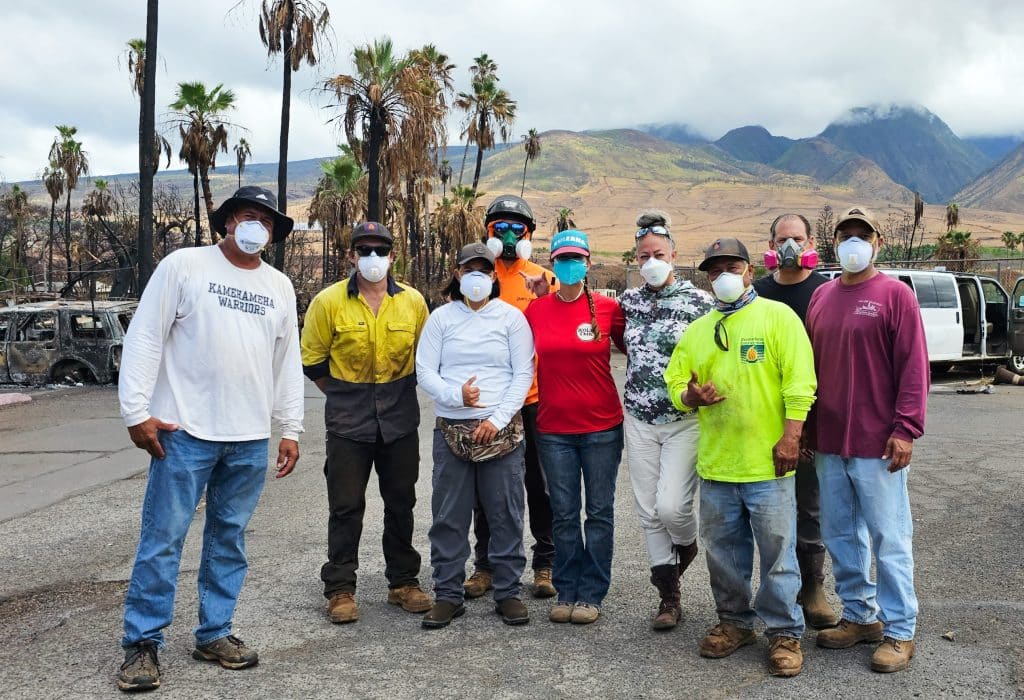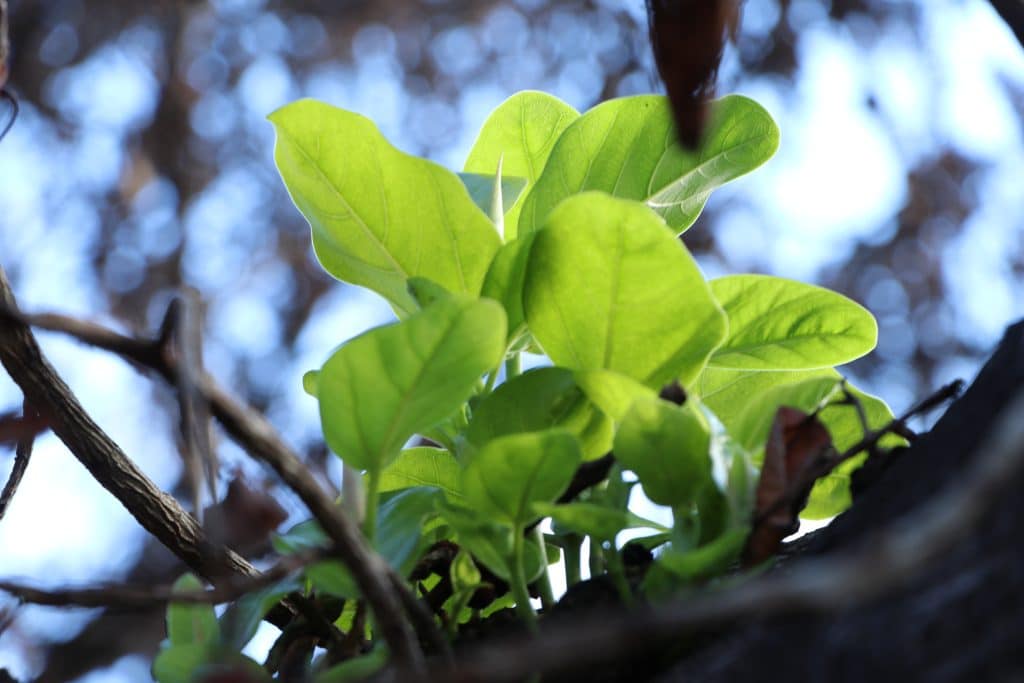Lāhainā’s Historic Greenscape – The Royal ‘Ulu Grove and Historic Banyan Tree Stands as Symbols of Hope and Resilience”.
Posted on Oct 2, 2023 in Main

From left to right: Jesse Neizman – chief engineer, Lāhainā Restoration Foundation; Ryan Grant – superintendent, Prometheus Construction; Jade Chihara – ‘āina koa, lateral root of Lāhainā; Jake Kane – arborist, Kane’s Legacy Trees; Gretchen Losano – founder, West Maui Green Cycle; Lorra Naholowa‘a – soil specialist, Naholowa‘a Earth Works LLC; Jaimie Cabalo – ‘āina koa, Prometheus Construction; Hōkuaō Pellegrino- 7th generation farmer/educator; Kalapana Kollars – cultural programs director, Lāhainā Restoration Foundation. Photo credit: Anuhea Kollars – cultural practitioner, Lāhainā Restoration
In the heart of Lāhainā, around the time an iconic Indian banyan tree was planted by Sheriff William Owen Smith on April 24, 1873, Hawaiians were trying to save their beloved ‘ulu (breadfruit) grove which flourished and fed its community for generations. 150 years later the effort to save them both is in full motion.
 The Maui County Arborist Committee has diligently overseen Lāhainā’s historical and exceptional treescapes’ well-being, ensuring its living landmarks remain symbols of our rich heritage. The Banyan’s sprawling branches stretch over two-thirds of an acre, providing shade and a gathering place for generations of locals and visitors. The beloved ‘ulu grove or Malu ‘ulu ‘o Lele means “the shaded breadfruit grove of Lele,” just one of the historical Hawaiian names for Lāhainā. Moku‘ula was an island in Lāhainā surrounded by a fishpond fed by natural springs. Moku‘ula was the home of Hawai‘i Ali‘i, Kings, Chiefs, and Chiefesses. The few Kumu ‘Ulu that survived until the fire were mostly offspring of the original grove which fed Hawai‘i’s Ali‘i and generations of Kanaka.
The Maui County Arborist Committee has diligently overseen Lāhainā’s historical and exceptional treescapes’ well-being, ensuring its living landmarks remain symbols of our rich heritage. The Banyan’s sprawling branches stretch over two-thirds of an acre, providing shade and a gathering place for generations of locals and visitors. The beloved ‘ulu grove or Malu ‘ulu ‘o Lele means “the shaded breadfruit grove of Lele,” just one of the historical Hawaiian names for Lāhainā. Moku‘ula was an island in Lāhainā surrounded by a fishpond fed by natural springs. Moku‘ula was the home of Hawai‘i Ali‘i, Kings, Chiefs, and Chiefesses. The few Kumu ‘Ulu that survived until the fire were mostly offspring of the original grove which fed Hawai‘i’s Ali‘i and generations of Kanaka.
The recent wildfire devastated much of Lāhainā’s historic area, leaving uncertainty about the future. But amid the ruins, buried beneath the scorched earth and standing tall above the remnants of buildings are beacons of hope, live roots from our Kumu ‘Ulu and the strong trunk, limbs, and branches of our 150-year-old banyan tree. Although scarred from the fire, it now symbolizes endurance and hope, and both are living legacies of a rich Hawaiian history.
Efforts to revive the survivor trees were underway once Lāhainā was deemed safe for entry. Hawai‘i arborists worked to identify survivor trees and deploy a care plan for the trees within days of the fire. Water had to be trucked in. Soil fertility specialists came in with a custom compost extract to aid recovery and encourage new root growth. The trees are also being monitored with growth sensors, soil is being tested, and roots have been extracted for regrowth. Experts, including cultural practitioners and historians, came for the greening of Lāhainā, volunteering their time, equipment, and aloha. It is a blessing to have Lāhainā’s own Restoration Foundation generational employees heed the kahea (call) and guide the charge with their knowledge of the forever changed but familiar landscape. Concerned calls came from around the world to offer kōkua and well wishes. The hypervigilance has subsided to let nature take its course after giving it the resources it needs to rise. New root growth has been confirmed and leaves are emerging.
While it’s uncertain how long this recovery journey may take – whether weeks, months, or even years – the Lāhainā treescape history embodies resilience, unity, and the enduring spirit of Lāhainā’s historic legacy.
Mahalo to Steve Nimz, lead arborist, his team Ilana Nimz and David Golden, Lorra Naholowa‘a, who organized a team of volunteers, all experts and professionals who generously rushed in to kōkua, including Jesse Neizman (7th generation Lāhainā), Anuhea and Kalapana Kollars, Chris Imoti and team, Gretchen Losano, Jake Kane, Dr. Noa Lincoln, Hokuau Pellegrino, Jade Chihara, Duane Sparkman, and Kai McPhee. Also, mahalo to Goodfellow Bros. LLC for watering; Prometheus Construction for labor and sponsoring the crew; Theo Morrison, executive director of Lāhainā Restoration Foundation; and all who have played an important role in preserving Lāhainā’s greenscape and will continue in this role in the future.